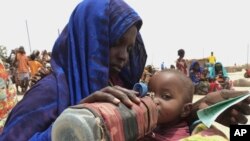Since the dawn of humanity, extreme poverty has held back progress, stifling hopes and undermining growth across the centuries. “Today,” said U.S. Agency for International Development Administrator Rajiv Shah, “we stand within reach of a world that was simply once unimaginable: a world without extreme poverty.”
Families who live in extreme poverty must make daily choices among food, medicine, housing, and education. Extreme poverty is not a precise measure of income or food consumption per day, but a denial of basic freedoms and basic human dignity.
It doesn’t have to be this way. There is now a roadmap out of extreme poverty that is driven by broad-based economic growth and transparent democratic governance. Since 1999, the total number of extreme poor has declined by nearly 50 million people every year, on average. Most experts believe that by 2030, the extreme poverty rate can be lowered to roughly three percent globally or 200 million people.
The key to such success is not just dollar investments alone, but a new model of development that creates public-private partnerships that deliver measurable results. The model is based on political leadership and policy reform as preconditions to drive investment to the regions where it will have the biggest impact on reducing extreme poverty and childhood hunger and death.
The United States’ Power Africa initiative is a great example. It encourages countries to make energy sector reforms while connecting entrepreneurs to investment opportunities that are created by those reforms.
Throughout the world the results of such global partnerships are becoming increasingly clear. In Ethiopia, for example, DuPont is building a seed distribution system to reach 30,000 smallholder maize farmers and increase productivity by 50 percent. After the Ethiopian government liberalized its seed sector, USAID provided supporting infrastructure investments.
One of the biggest challenges to development remains conflict. Fifteen years from now, the effort to end extreme poverty will largely have failed or succeeded on whether development policy and practice can serve alongside efforts to usher in peace, security, and stability.
The United States remains committed to ending extreme poverty through a new public-private model of development that can achieve broader results beyond public investment alone.
Families who live in extreme poverty must make daily choices among food, medicine, housing, and education. Extreme poverty is not a precise measure of income or food consumption per day, but a denial of basic freedoms and basic human dignity.
It doesn’t have to be this way. There is now a roadmap out of extreme poverty that is driven by broad-based economic growth and transparent democratic governance. Since 1999, the total number of extreme poor has declined by nearly 50 million people every year, on average. Most experts believe that by 2030, the extreme poverty rate can be lowered to roughly three percent globally or 200 million people.
The key to such success is not just dollar investments alone, but a new model of development that creates public-private partnerships that deliver measurable results. The model is based on political leadership and policy reform as preconditions to drive investment to the regions where it will have the biggest impact on reducing extreme poverty and childhood hunger and death.
The United States’ Power Africa initiative is a great example. It encourages countries to make energy sector reforms while connecting entrepreneurs to investment opportunities that are created by those reforms.
Throughout the world the results of such global partnerships are becoming increasingly clear. In Ethiopia, for example, DuPont is building a seed distribution system to reach 30,000 smallholder maize farmers and increase productivity by 50 percent. After the Ethiopian government liberalized its seed sector, USAID provided supporting infrastructure investments.
One of the biggest challenges to development remains conflict. Fifteen years from now, the effort to end extreme poverty will largely have failed or succeeded on whether development policy and practice can serve alongside efforts to usher in peace, security, and stability.
The United States remains committed to ending extreme poverty through a new public-private model of development that can achieve broader results beyond public investment alone.















